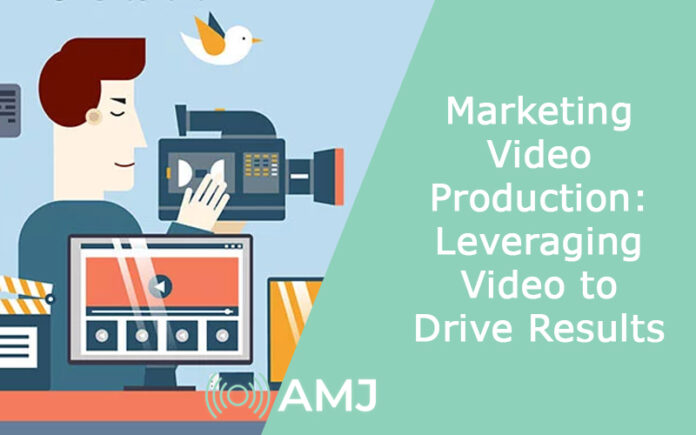Essentially, a marketing video is a video meant to promote or market a product, service, idea, or cause. It can be either short-form or long-form, and it is used to capture attention and engage an audience in the message being conveyed.
Video production for marketing purposes encompasses all aspects of the video-making process, from pre-production (concept development) to post-production (editing and delivering the final piece).
In this article, you’ll learn all about marketing video production and how to create the right strategy for your brand.
Contents
What makes an effective marketing video?
The best marketing videos drive impact! Unfortunately, there’s no black-and-white answer to what makes a video perform well, which is why marketing is largely a “test and iterate” process. All that being said, there are a few key elements to consider when evaluating your video’s success:
- Storytelling — A good story can go a long way in creating an emotional connection with viewers and driving engagement.
- Visuals — Compelling visuals will help draw attention to the video and keep viewers interested.
- Originality — Aim to highlight what makes you different (or create imagery that positions you differently).
- Quality — Production value matters, especially when it comes to longer-form videos. Don’t skimp on the things that will tie your video together in the end (e.g., sound, editing).
Beyond that, ad creative is exactly that: creative.
Lots of the time, short-form content is more effective for driving conversions, while long-form video is better suited to start conversations and deepen relationships with your customers.
The most important factor in marketing video success is whether or not you meet your audience’s needs. Think critically about who your audience is, what your viewers want, and how you can deliver it memorably.
Different Types of Marketing Video Production
Depending on your brand’s goals and target audience, you’ll probably create a different kind of video. Let’s take a look at the main types of video marketing and where they work best.
1. Commercials
Commercials for traditional TV and CTV platforms (e.g., Roku, Hulu, etc.) are short-form (15-30 seconds) designed to get initial attention. They should be dynamic and show off your company or product’s most exciting features.
Commercial videos are the most common kind of marketing video—you’ve probably seen countless on TV channels, streaming services, or YouTube. They aim to attract new customers and often have a broad appeal, providing only essential information that the viewer needs.
Including them on your website or homepage is also beneficial as they offer a brief and effortless way to grasp your brand mission and give a general overview of your brand.
2. Social Media
Social media videos are an essential part of any paid or organic social campaign. They’re meant to be engaging and fun, with the ultimate goal in mind of shareability.
Social content spreads awareness through shares—its reach and engagement can rise exponentially through the power of people. Use short-form (1-minute maximum) video clips that are creative and relevant to your target audience are the way to go here. Keep them authentic, conversational, and on-brand.
3. Explainer Videos
Explainer videos provide an in-depth look at a product or service, helping educate viewers about what you do.
Explainer videos are a great way to highlight the unique value that your company brings. They work best in an online environment, placed on your website and landing pages for maximum impact.
They aren’t the first step in your marketing funnel—most viewers who convert off of explainer videos have already heard about you and are just looking for more information.
4. Testimonials and Case Studies
Testimonials are powerful because they come from existing customers, not the company itself. They help build trust, show that your products or services really deliver results, and can influence viewers to take action.
If you keep your testimonials under 30 seconds and only highlight your value, they’ll be effective in any marketing video campaign you launch.
Case studies are similar in that they provide evidence-based stories of success, but they’re somewhat different. These long-form videos (3 minutes or more) tell a story about how your product or service has helped someone achieve their goals and should include interviews with customers to make them relatable.
Creating the Right Video Marketing Strategy: A Quick Look
It is important to research and plan before creating a digital marketing video—just as you would before buying airtime for a commercial during the Super Bowl. Your video marketing strategy will act as a guide for your budget, timelines, production processes, conversion metrics, and other aspects. Therefore, making a finalized plan should be the first step of your video creation process since it will ultimately direct all other decisions.
Briefly, here’s an overview of the steps.
- Start with measurable video goals. Your main goals should be quantifiable and metrics-based, such as increasing brand awareness or driving website conversions.
- Pinpoint your target audience. Most companies have multiple target audiences—and in order to create effective content, you need to know exactly who you are targeting.
- Align creative requirements with your overall brand. Consistency is key, especially when moving your audience through the marketing funnel. Your video should reflect your brand’s personality and messaging.
- Develop a concept that captures your audience. Consider the values and messages you want to convey in the video, your target audience, and any competitors’ videos for inspiration. Then create a script and storyboard for the video with all pertinent information included.
- Stick to your predetermined timeline. Things happen. But if you have a timeline and stick to it, your production process will run smoother.
- Execute the production. This is the most time-intensive part of video marketing production—shooting, editing, mixing audio, etc. Choose the right team for each job and ensure that everyone has all the necessary materials in order to meet deadlines.
Final Thoughts
From concept and storyboarding to production, post-production, and beyond—a successful video marketing campaign requires careful planning every step of the way. When your video is part of a larger plan for success, you can measure its performance and make adjustments as needed.
By following these steps, you’ll be able to create a video that captures your brand’s audience and highlights the unique value it brings.












![Index of Money Heist [Season 1, 2, 3 & 4 – All Episodes, Cast and Plot] Index of Money Heist](https://www.asiamediajournal.com/wp-content/uploads/2021/05/Index-of-Money-Heist-3-100x70.jpg)